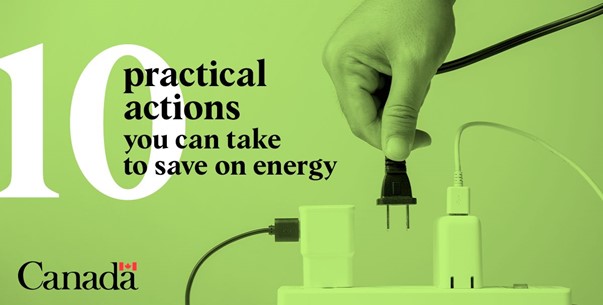Case Study Overview
The bilingual (English and French) #WaysWeSave campaign was launched to help Canadians respond to the increased cost of living, including rising energy bills. The multi-phased educational campaign promotes tips to help people reduce their energy consumption and encourage Canadians to lead a more energy efficient lifestyle while saving money and being environmentally conscious.
Design
Target audience: Primary target audiences included homeowners and renters of all economic levels and equity groups looking to save money during a period of economic uncertainty, as well as individuals and families looking to have a positive impact on the environment. Secondary target audiences included young adults and students (aged 17-24) who may not own property but pay utility bills , and older adults (aged 55+) considering life changes.
The campaign took into account public opinion research on accessibility and inclusivity for home energy efficiency programs, which showed that many Canadian homeowners with the means to conduct home retrofits do not consider it a requirement, while those Canadians living in a more financially precarious situation, who are more affected by even a modest increase in their energy bills, don’t feel they have the financial means to undertake deep retrofits.
Objectives and messages: The campaign aimed to increase the target audiences’ awareness of energy efficiency; position the Department of Natural Resources as a trusted source of information on energy efficiency and affordability; and build a shared understanding of the problem and potential solutions to motivate the target audiences in understanding their role in the net-zero transformation. Key messages were:
- The global energy crisis, rising inflation and the post-pandemic environment affect virtually every sector of society, from food production and transportation to the cost of energy for homes, manufacturing and supply shortages, and other activities.
- The cost of living is increasing and that means people worry more about costs at the grocery store and the gas station, as well as energy use at home and paying bills at the end of the month.
- Canada is dealing with dual crises: energy security and climate change, and we need to address both while keeping energy affordable for families.
- The country is leading the way in the transition to a net-zero future. Canada has key resources the global economy needs, a comprehensive climate plan, industry support, and skilled workers to build a sustainable future for all.
- The ability to make progress on energy transition hinges on individual and collective choices. We all have a role to play.
- Using energy more efficiently and reducing the demand are ways that people can help increase energy security and make progress towards achieving our climate goals.
- There are ways to use less energy, to save money and still get what we need done.
Resources: Internal resources included staff from the Department of Natural Resources’ communications, marketing, policy, energy efficiency, data analytics, social media, stakeholder engagement, and translation teams.
The most important lessons learned: Defining clear campaign objectives, identifying target audiences, and using measurable goals helped to increase the effectiveness of the campaign.
Implementation
Media channels used: Social media served as the basis for the campaign, using the platforms of X (formerly Twitter), Facebook and Instagram (stories) to direct users to the new campaign landing page, “Save Money on Energy” Content was adapted according to the season (i.g. winter versus spring) to be relatable for users. From November to December 2022 (winter season) posts were organic, whilst in March 2023 (spring season) posts were sponsored or boosted. During the campaign period, the advertising approach was also shifted from boosting organic posts on X and Facebook to posting ads on Instagram stories instead. This shift was necessary due to the large number of comments received by the audience that were either negative, out of scope, or political in nature. As the main advertising objectives were to raise awareness and drive the audience to the campaign landing page, this shift in tactics was used to bring attention back to the campaign messaging rather than the discussions and comments being generated on these platforms”.
Campaign material used clean and strong imagery paired with a bold yet inviting colour palette. This supported the written messaging and the campaign’s tone as light and down to earth, with a playful energy. The tagline #WaysWeSave or #NosMoyensDÉconomiser was recommended as data showed that:
- using the word “save” captures the attention of homeowners burdened with high costs;
- the chosen language can help reframe widespread misconceptions that all home improvements are costly and inaccessible;
- the flexibility of the tagline’s positioning enables the promotion of related activities and programmes which promote energy saving, money saving and environmental benefits;
- the tagline allows for open dialogue around energy use and the ability to make change,
- the hashtag matches and easily translates in both official languages.
Recommended measures: The campaign approach was to highlight existing governmental programmes, such ENERGY STAR® and the Canada Greener Homes Initiative, and included:
campaign approach was to highlight existing governmental programmes, such ENERGY STAR® and the Canada Greener Homes Initiative, and included:
- immediate actions to reduce energy use and save money, such as draught stripping or switching to LED lighting;
- taking a closer look at their energy usage, by for instance installing a smart thermostat;
- simple changes in daily habits such as walking, biking, carpooling or using public transport to get to work;
- making improvements to energy systems that will reduce energy use and overall costs such as replacing old appliances for more efficient ones.
Stakeholder involvement: Natural Resources Canada has a unique role in educating Canadians about their energy options, while providing energy efficiency tips and solutions that will not only save money, but also support a net-zero future for Canada.
The most important lessons learned: To better formalise campaign planning for paid advertising activity, it is recommended to explore tactics beyond social media, lengthen the timeline of the campaign in the market and better prepare for technical issues and outages generated by the platforms themselves. An interesting takeaway was that on Instagram stories and motion graphics well outperformed static images in English while the opposite was true in French.
Tracking
Impacts and outcomes: While the campaign reached a wide audience of Canadians, it did receive negative comments on X and Facebook. As a result, the transition to a single channel (Instagram stories) was undertaken to better focus attention on the advertising message and objectives and not the use of the platform for comments. Phase II of the campaign is under development and will monitor whether new adaptations increase effectiveness. Outcomes on energy consumption attributable to the campaign were not measured in the first phase.
The most important lessons learned: The first phase of the campaign was used to test options and messaging. As a result, the second and subsequent phases of the campaign will be more targeted and likely more effective.
Campaign Summary
| Agency | Department of Natural Resources |
| Slogan | Ways We Save / Nos Moyens D’Économiser |
| Website | |
| Contact person | Natalie Irwin (natalie.irwin@nrcan-rncan.gc.ca) |


